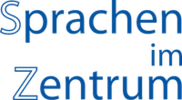German Sign Language
Since 1 May 2002, German Sign Language has been legally recognised by the Federal Equal Opportunities Act. It is not German made visible through signs, but a language of its own with grammar, syntax, vocabulary, morphology and pragmatics. In contrast to spoken German, DGS is a visual language that is in no way inferior to spoken languages in terms of complexity and expressiveness.
These courses are aimed at hearing people who are interested in basic knowledge of sign language. Interested students with hearing impairments and no previous knowledge can also take part in the courses.
In the beginners' course, the focus is on the introduction to the independent language and grammar of sign language. Basic visual, non-verbal communication is practised through body language, facial expressions and finger alphabet. Everyday conversational situations are tested. In the advanced course, the basics of DGS are deepened and extended.
Course materials are purchased during the course.
The teacher herself is deaf, the first lesson of the beginners' course is accompanied by a sign language interpreter.
The prerequisite for participation in DGS 2 is successful participation in DGS 1.
German Sign Language 1
This module takes place every semester. It has a scope of 28 teaching hours. 3 credit points are awarded for successful participation. The course is aimed at learners with no previous knowledge. After successful participation in the DGS 1, the participant will be able to communicate with deaf people in the beginning. The focus is on visual communication. Through non-verbal communication, students will become accustomed to communicating without a voice. The students will learn to have simple conversations in German sign language, for example, to enter into a conversation through greetings. They will be introduced to German sign language in a playful way. At the beginning of the course there is an introduction to sign language, deaf culture and deaf history with the sign language interpreter. This is an opportunity to clarify initial questions. Communication in a simple way is possible if the interlocutors sign slowly and clearly and are willing to help. In each of the two modules, performance is assessed via a semester-long portfolio consisting of 4 parts (3 receptive parts in the form of individual tests and a guided sign language dialogue at the end of the course as a productive performance). This results in the overall grade. Successful participation requires that the overall grade is at least 4.0.
German Sign Language 2
This module takes place every semester. It has a scope of 28 teaching hours. 3 credit points are awarded for successful participation. The course is aimed at learners with previous knowledge, at best participation in DGS 1. If other previous knowledge is required, an examination may be necessary before attending the advanced course. After successful participation in the DGS 2, the learners have mastered an elementary general visual sign vocabulary and the first basic structures and means of expression of German sign language. They have mastered simple communication in everyday situations and can give and obtain simple information (e.g. education, job, family, home, directions and other occasions for communication). They can follow simple content receptively and reproduce it productively. The students gain further insights into the socio-cultural life of deaf people. In each of the two modules, performance is assessed via a semester-long portfolio consisting of 4 parts (3 receptive parts in the form of individual tests and a freely conducted sign language dialogue at the end of the course as a productive performance). This results in the overall grade. Successful participation requires that the overall grade is at least 4.0.
Lecturer
The teacher is herself hearing impaired and a native speaker. She has a wealth of knowledge about the life of deaf people, their deaf culture and is an expert in this field. She is active as a volunteer in several areas of work with the deaf. She has various qualifications in sign language teaching and sign language interpreting.
Contact with the courses and their organisation is only through the Language Centre: sprachenzentrum@uol.de.
Contact with the lecturer will only take place during the course.



